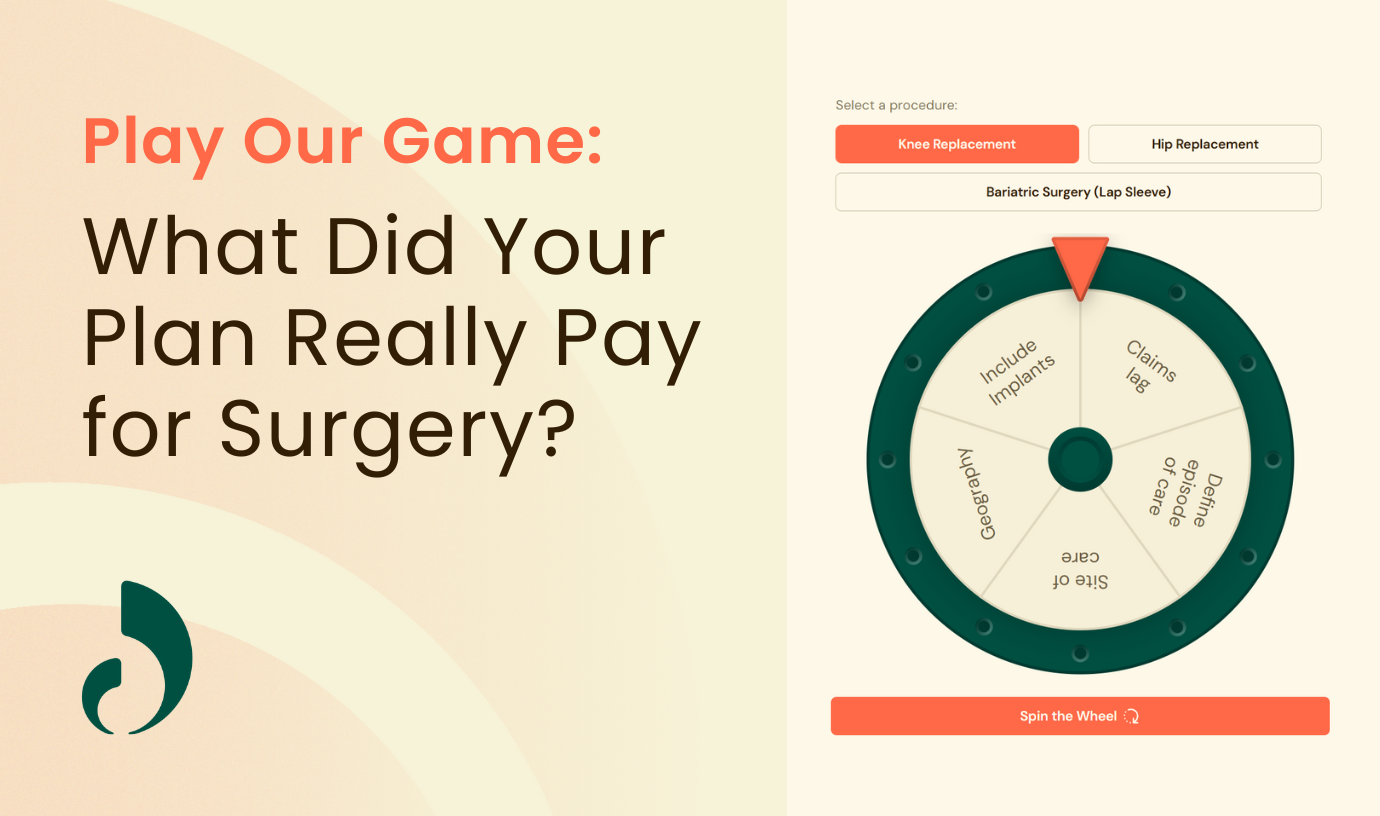Rising healthcare costs are an ever-present challenge for employers and unions, and benefits leaders are often stuck in the difficult position of balancing employee care with financial sustainability.
While specialty care, such as surgery, cancer care and infusions, impacts only a small fraction of employees, it can drive up to 50% of an organization’s total healthcare spend. Specialty care is quickly becoming the leading contributor to healthcare spending.
Traditional Centers of Excellence (COEs) have long been seen as a solution to address costs for specialty care, yet many fail to deliver meaningful cost savings or consistently better outcomes. Worse still, utilization remains low, leaving benefits teams frustrated and skeptical.
But not all COEs are built the same.
A new model is gaining traction: The independent Center of Excellence. This approach operates separately from other programs by laser focusing on quality, outcomes and accountability. Independent COEs prioritize the needs of employers and employees, offering measurable improvements in both experience and results.
In this blog, we’ll explore what sets independent COEs apart, the core benefits and services, and how to evaluate Center of Excellence vendors.
Defining a Center of Excellence (COE)
A Center of Excellence is a curated network of healthcare providers and facilities that delivers high-quality, cost-effective care for complex or expensive procedures like surgeries, cancer treatments and infusions. For employers, COEs are meant to streamline access to top-tier care while reducing unnecessary costs and complications.
Independent COE vs. Carrier-Based COEs
When evaluating options, you’ll typically run into three types of COEs, and each offer pros and cons:
Carrier COEs: These are built by insurance companies and folded into existing health plans. They’re convenient and easy to implement, but often come with limited customization. Many employers find they don’t produce meaningful cost savings and see low utilization.
Facility-Centric COEs: These involve direct partnerships with specific hospitals or health systems. While they may offer brand-name recognition and strong regional care, they often limit employee choice and geographic flexibility. Members who live far from the designated center often have to travel long distances for care, which negatively impacts utilization.
Independent Third-Party COEs: Independent COEs are created by specialized organizations that build high-performance networks from the ground up. These programs don’t rely on hospital systems or insurers. Instead, they vet individual physicians based on outcomes, experience and cost efficiency, offering employers a truly customized and transparent solution.
Independent COEs vs. Health Plan COEs: What’s the Difference?

Why Independent COEs Matter
Put simply: Independent COEs give employers more control over the care experience and the bottom line. By sidestepping traditional health plan networks, these models unlock deeper savings through direct contracting and better visibility into outcomes.
More importantly, they’re designed to put quality first by evaluating providers at the individual level rather than relying solely on facility reputations. In short, independent COEs are built to work for you, not the carrier or the hospital.
Why Consider an Independent COE Solution Like Lantern?
For years, benefits leaders have turned to Centers of Excellence, hoping to reduce rising specialty care costs. But many traditional models haven’t delivered the savings or the experience employers or unions expected.
That’s where independent COEs, like Lantern, change the game. Here’s how:
Lower Costs Without Compromising Quality
Independent COEs are built to drive real cost savings. By bypassing intermediaries and contracting directly with top-performing surgeons and facilities, these models negotiate competitive, transparent rates.
Lantern, for example, offers bundled pricing that averages 130% of Medicare rates—a stark contrast to carrier networks that often exceed 250 to 300%. Plus, fewer complications and unnecessary procedures mean lower downstream costs.
Employers and unions often pass these savings on to their workforce by eliminating copays and other fees. In many cases, employees pay nothing for high-cost procedures.
“Having a solution like Lantern removes those barriers and helps our associates access affordable, high-quality care,” says Recharda Graydon, Senior Benefits Manager at HD Supply. “Because again, some associates will skip care either due to costs or access.”
Better Outcomes You Can Count On
Cost control is only half the story. Independent COEs also prioritize clinical quality. Lantern’s network, for instance, is built around the best individual surgeons, not just big-name hospitals. This results in a complication rate of less than 1%, well below industry benchmarks. That means healthier outcomes, fewer readmissions and less time lost to recovery.
When appropriate, Lantern also helps steer employees to less-invasive procedures, such as physical therapy. Lantern providers achieve a 20%+ surgical avoidance rate, ensuring members get surgery when they truly need it.
A Better Experience for Employees and Union Members
When employees and union members have access to high-quality, localized care, they’re more likely to use it. Lantern’s approach offers personalized support, shorter wait times and care closer to home. There’s no confusing plan navigation or cross-country travel just to see a specialist.
Our network of specialists includes more than 2,000 surgeons and 725+ facilities across the country, placing 98% of members within driving distance of their appointments.
“We really wanted a strong local network,” says Dawn Beaudin, Vice President, Benefits at Hyatt Hotels. “One of the reasons we felt comfortable introducing Lantern was that our colleagues were within driving distance of a Lantern-affiliated surgeon.”
Why Traditional COE Models Miss the Mark
Older COE models often stumble on two fronts: They require employees and union members to travel long distances, and they lack clear communication or incentives. As a result, utilization stays low. That’s wasted potential for employees and for your health plan.
The Lantern Difference
Lantern flips the traditional COE model on its head. By taking a surgeon-first approach, we build networks around top specialists and layer in supportive, locally based care. That means fewer barriers, more informed decisions and a better experience for everyone involved.
Center of Excellence Buyer’s Guide
- Guidance on preparing for conversations with COE networks
- Challenges and considerations when selecting a COE
- And much more!

What Types of Procedures and Care should be Covered through a COE?
When most people hear “Center of Excellence,” they think of surgery, and that’s a big component. But in reality, COEs can cover a much broader range of complex, high-cost medical needs that drive a large portion of your healthcare spend.
Surgery: Surgical procedures like orthopedic, spine, joint and bariatric are some of the most frequent and expensive interventions in employer-sponsored healthcare. In fact, surgery alone accounts for about 20% of total healthcare spending. A Center of Excellence for surgery benefits helps employers and labor unions ensure that surgical care is high-quality, appropriate and priced transparently through bundled payments. Lantern, for example, covers all plannable procedures across one network.
Cancer Care: Cancer alone accounts for around 12% of an employer’s health spend. A cancer COE for employees connects them to leading oncologists, multidisciplinary teams and advanced treatment centers, ensuring care decisions are timely, evidence-based and aligned with each patient’s unique diagnosis.
Infusion Therapies: Infusion medications for autoimmune diseases or cancer treatments are another growing cost concern. Many employers overpay simply because infusions happen in high-cost hospital settings. COEs help redirect care to lower-cost outpatient or in-home options without compromising safety or outcomes.
What do all these healthcare services have in common?
They’re expensive, complex and highly variable in quality. That’s exactly why members benefit from a Center of Excellence approach. When benefits leaders can ensure the right care happens with the right provider in the right setting, the results are clinically and financially better for everyone.
What to Look for in an Independent COE Solution
When it comes to designing a more effective specialty care solution, there’s no one-size-fits-all solution, especially for complex conditions. Independent COEs offer a powerful solution because they offer the flexibility and precision today’s organizations need.
Here’s what to consider when building a COE benefits strategy.
Start with the Data
The smartest first step is to look closely at your organization’s healthcare data. What’s driving your costs? For some companies and unions, it’s surgery. For others, it might be cancer care, musculoskeletal conditions or a mix of high-cost treatments.
An independent COE model gives you the ability to tailor the solution based on what your workforce actually needs—no unnecessary programs, no wasted spend. It may make sense to only add a musculoskeletal COE as part of your employee healthcare benefits.
COEs Should Integrate with Existing Benefits
Independent COEs aren’t just another point solution. The right partner will help you integrate your COE with other benefits you already offer, like second-opinion services, virtual physical therapy or condition-specific support programs. That kind of coordination leads to better decisions, more engaged employees and improved outcomes across the board.
Instead of juggling separate contracts and vendors, benefits leaders can often activate the COE through their health plan and focus their time on communication, plan design and employee engagement in healthcare.
Take a “Provider-First” Approach
Quality care starts with the right provider, not just the right building. Independent COEs like Lantern take a “surgeon-first” or “provider-first” approach, vetting physicians at the individual level based on performance, experience and outcomes. That means your workers aren’t just going to a recognized facility, but seeing the best doctor for their specific situation.
Lantern’s independent approach looks at factors like sub-specialization, board certification, fellowship training, procedure volume and appropriateness of care, in addition to evaluating the facilities where they operate.
“Knowing that there’s this long list of quality indicators that Lantern vets out on behalf of an employee health plan really helps the decision for us to be much more comfortable with sending participants to Lantern,” says Kim Baker, Senior Advisor of Health and Wellness Benefits at a diversified energy manufacturer and logistics company with almost 12,000 employees dispersed coast to coast.
Look for an Independent COE Partner, Not a Vendor
An independent COE provider isn’t just a vendor, they’re a strategic ally. With deep data insights, clinical expertise and flexible program design, they can help you build a benefits strategy that’s aligned with your goals and your people. Whether you’re solving for cost, experience or outcomes, a well-matched COE partner helps you get there faster.
“One of the things I really like about Lantern is their desire to innovate and listen to their clients. They’re always coming to us to say, ‘How do you like this?’ or ‘We have something fresh to help engage your associates,’” Graydon says. “It helps to keep the partnership strong, because they’re not only collecting the feedback but actually implementing what they receive from their clients.”
“Knowing that there’s this long list of quality indicators that Lantern vets out on behalf of an employee health plan really helps the decision for us to be much more comfortable with sending participants to Lantern.”
What to Avoid When Choosing a COE Solution
Be cautious of COE programs that rely heavily on a few “name brand” hospitals. Even world-renowned facilities have low-performing providers. While these may look good on paper, they often limit access and increase travel-related friction. Also beware of partners that can’t (or won’t) share clear quality metrics or cost-saving outcomes. If they can’t provide it, they probably can’t deliver it.
Questions to Ask a COE Provider During RFP
Before committing to a COE provider, ask:
- How are providers selected and vetted?
- What’s the average distance employees will need to travel?
- How do you manage healthcare cost containment?
- Can you share your complication rates or patient outcomes?
- How do you engage employees and drive utilization?
- In addition to surgery, do you support cancer care and infusion therapy management?
30 Questions to Ask When Assessing COEs

The Importance of Support: Why Care Advocates Are Essential
Navigating a serious health issue is never easy. For many members, figuring out where to go, what it will cost and how to prepare for treatment can be overwhelming. That’s where Care Advocates come in.
The Human Touch in Healthcare
Even with the best providers and pricing in place, employees and union members still need help making sense of it all. Complex care comes with complicated logistics, and most people don’t know where to start. Lantern’s Care Advocates provide the human connection that makes the experience manageable and compassionate.
What a Care Advocate Does
Think of a Care Advocate as a dedicated guide who walks alongside your workforce throughout their entire care journey.
They help:
- Schedule appointments and consultations
- Explain procedure costs and benefits coverage
- Coordinate logistics like lodging, transportation and meals
- Arrange second-opinion reviews before major treatments
- Answer questions and provide emotional reassurance along the way
“We’ve had associates who spoke with a Care Advocate and found out they had other options,” Graydon says. “Having the Care Advocate as a resource has been a big help, and the data shows we’ve seen savings just from people utilizing other solutions outside of surgery.”
This isn’t like speaking to a stranger in a call center. It’s personalized, one-on-one support that meets people where they are, especially when they’re dealing with life-altering diagnoses or major procedures.
Why It Matters for Employees and Union Members
When employees and union members feel supported, they’re more confident in their decisions and more likely to follow through with care. That leads to better outcomes, reduced anxiety and a smoother recovery. And when someone else handles the travel details or paperwork, employees can focus on getting better.
Why It Matters for Companies and Unions
For HR and benefits teams, Care Advocates are a game-changer. They take the pressure off your internal teams by serving as the first point of contact for anything related to the COE experience. That means fewer benefits-related questions in your inbox and a more consistent, professional experience for your people.
See how care advocacy works in real life.
Check out Cecily’s Lantern Story: “It was Honestly a Lifesaver”
“Ashley answered every question I had on how to even get started, how to file a claim, what doctors to go to. She was always so helpful and kind and very patient, and I couldn’t have asked for a better representative.”
How to Get Members to Use Their COE Benefits
You can design the most cost-effective, high-quality COE program in the world, but if employees and union members don’t use it, none of that matters.
One of the biggest hurdles with traditional COE programs is low utilization. Often, employees don’t even know the benefit exists. It’s mentioned briefly during open enrollment and then forgotten.
When a complex diagnosis hits, most people default to whatever provider their primary care doctor refers them to, regardless of cost or quality.
How to Increase Employee Utilization of COE Benefits
To get real value from your COE program, you need an active strategy to drive awareness, trust and usage. Here’s what works:
Offer Meaningful Incentives: Financial incentives are powerful motivators. Consider waiving deductibles and out-of-pocket costs for employees who choose COE care. Covering travel, lodging and meals removes additional barriers, especially for lower-income employees.
Communicate Consistently: Don’t wait until open enrollment. Build a year-round communication plan that includes emails, manager toolkits, intranet resources and real member stories. The goal is to make sure the COE benefit is top of mind before someone needs it.
Design with Intention: Smart plan design can drive behavior. Mandatory COE participation often delivers the highest utilization and biggest cost savings, but it can come with pushback if employees feel restricted in their choices.
A voluntary approach gives more flexibility, but typically sees lower adoption unless it’s backed by strong incentives and communication. There’s no single “right” answer as it depends on your workforce culture and benefits strategy.
Need a game plan? Download Your Playbook to Drive Utilization.
Take the Next Step Toward Smarter Specialty Care
Centers of Excellence offer an effective way to improve care quality and control costs for high-impact conditions like surgery, cancer and infusion therapy.
An independent COE solution isn’t just another benefit, but a strategic advantage. The right partner can help you reduce unnecessary costs, give your employees access to top-performing specialists and simplify complex care journeys with white-glove support. It’s a smarter, more personalized approach that aligns with today’s workforce expectations.
Learn How Lantern Can Help You Build a High-Impact COE Strategy
Contact us today to start the conversation to improve outcomes and cut costs.




